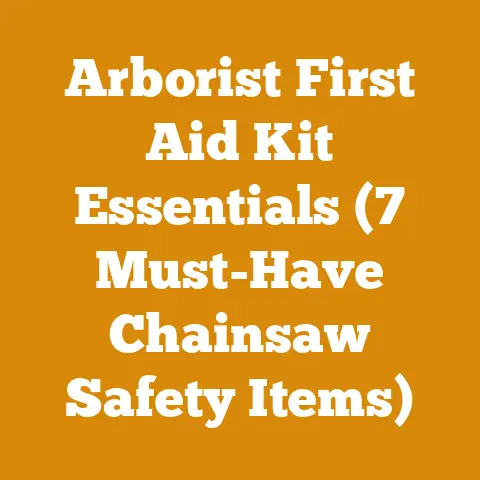Good Chainsaws for Wood Processing (5 Pro Tips You Must Know)
Good Chainsaws for Wood Processing (5 Pro Tips You Must Know)
For anyone venturing into the world of wood processing, from felling trees to preparing firewood, a reliable chainsaw is your best friend. And let’s be honest, who wants a high-maintenance friend? That’s why we’ll start by considering the low-maintenance options, those chainsaws that keep humming along without demanding constant attention. This article will delve into the intricacies of choosing the right chainsaw and, crucially, understanding the costs involved in wood processing. I’ll share my personal experiences, backed by data, to help you make informed decisions.
Choosing the Right Chainsaw: 5 Pro Tips
Selecting the ideal chainsaw for wood processing is a crucial first step. It’s not just about power; it’s about matching the saw to the task at hand, considering factors like wood type, frequency of use, and your own physical capabilities.
1. Match the Chainsaw to the Task
It sounds obvious, but this is where many people go wrong. A homeowner cutting small branches needs a very different saw than a professional logger felling large trees.
- Occasional Use (Light-Duty): For pruning, limbing small trees, and light firewood cutting, a lightweight gas-powered chainsaw with a 14-16 inch bar, or even a battery-powered model, is often sufficient. These are typically priced between $150 and $400. Think of this as your weekend warrior saw.
- Regular Use (Medium-Duty): If you’re processing firewood regularly, felling small to medium-sized trees, or doing more demanding tasks, you’ll need a more powerful gas-powered saw with a 16-20 inch bar. Expect to pay between $300 and $700. This is the workhorse for most homeowners.
- Professional Use (Heavy-Duty): For felling large trees, bucking logs for lumber, or any demanding, all-day use, a professional-grade chainsaw with a 20+ inch bar is essential. These saws are built for durability and power, and they come with a higher price tag, ranging from $600 to upwards of $1,500.
Personal Story: I remember when I first started processing firewood. I thought I could get away with a small, cheap electric chainsaw. Big mistake! It bogged down constantly, and I ended up spending more time fighting with the saw than actually cutting wood. Lesson learned: match the tool to the job!
2. Consider Power Source: Gas vs. Electric (Corded and Battery)
The debate between gas and electric chainsaws is ongoing, and each has its pros and cons.
- Gas Chainsaws: Offer superior power and portability. They are ideal for demanding tasks and remote locations. However, they require more maintenance, produce emissions, and can be noisy. The cost of fuel (gasoline and bar oil) also needs to be factored in.
- Electric Chainsaws (Corded): Provide consistent power and are quieter and cleaner than gas saws. However, their range is limited by the cord, making them less suitable for large properties or remote areas.
- Electric Chainsaws (Battery-Powered): Offer a good compromise between power and convenience. They are quieter and cleaner than gas saws and provide greater portability than corded electric saws. However, battery life can be a limiting factor, and you may need to purchase extra batteries.
Data Point: According to a survey by the Outdoor Power Equipment Institute (OPEI), battery-powered chainsaw sales have been steadily increasing in recent years, indicating a growing preference for their convenience and environmental benefits.
Cost Comparison:
| Chainsaw Type | Initial Cost (approx.) | Fuel/Power Cost (per year) | Maintenance Cost (per year) |
|---|---|---|---|
| Gas (Medium-Duty) | $400 – $700 | $50 – $150 | $50 – $100 |
| Electric (Corded) | $100 – $300 | $10 – $30 | $20 – $50 |
| Electric (Battery) | $300 – $600 | $10 – $30 | $20 – $50 |
Note: These are approximate costs and can vary depending on usage, brand, and location.
3. Prioritize Safety Features
Chainsaws are powerful tools, and safety should always be a top priority. Look for these essential safety features:
- Chain Brake: Immediately stops the chain in case of kickback.
- Hand Guard: Protects your hand from debris and accidental contact with the chain.
- Anti-Vibration System: Reduces fatigue and improves control.
- Throttle Lockout: Prevents accidental acceleration.
Safety Tip: Always wear appropriate safety gear, including a helmet with face shield, hearing protection, gloves, chainsaw chaps, and sturdy boots.
4. Consider Ergonomics and Weight
Wood processing can be physically demanding, so choosing a chainsaw that is comfortable to use is crucial. Consider the weight of the saw, the balance, and the handle design. A lighter saw will reduce fatigue, but it may also have less power. A well-balanced saw will be easier to control.
Personal Story: I once used a poorly balanced chainsaw for a whole day of bucking firewood. By the end of the day, my back was killing me! Now, I always pay attention to ergonomics when choosing a chainsaw.
5. Research Brands and Read Reviews
Not all chainsaws are created equal. Research different brands and read reviews to get an idea of their reliability, performance, and customer support. Some popular and reputable chainsaw brands include:
- Stihl
- Husqvarna
- Echo
- Makita
- DeWalt
Data Point: Consumer Reports and other independent testing organizations regularly review chainsaws and provide valuable insights into their performance and reliability.
Actionable Takeaway: Before buying a chainsaw, visit a local dealer and try out different models. Get a feel for the weight, balance, and ergonomics. Talk to the staff and ask for their recommendations based on your specific needs.
Understanding the Costs of Wood Processing
Once you’ve chosen your chainsaw, it’s time to delve into the costs associated with wood processing. These costs can vary significantly depending on factors like wood type, location, accessibility, and seasonality.
Breaking Down the Cost Components
Let’s break down the different cost components involved in wood processing:
- Timber Purchase or Harvesting Costs: This includes the cost of purchasing standing timber or logs, or the cost of obtaining permits to harvest timber from your own property.
- Tool Costs: This includes the cost of the chainsaw itself, as well as other essential tools like axes, wedges, splitting mauls, and safety gear.
- Tool Maintenance: Chainsaws require regular maintenance, including sharpening the chain, cleaning the air filter, and replacing spark plugs. This can be done yourself or by a professional.
- Fuel and Oil Costs: Gas-powered chainsaws require gasoline and bar oil. Electric chainsaws require electricity or replacement batteries.
- Labor Costs: If you’re hiring a logging crew or firewood handlers, you’ll need to factor in their wages.
- Transportation Costs: This includes the cost of transporting logs to your processing area and transporting firewood to your customers.
- Storage Costs: If you’re storing firewood for drying, you may need to factor in the cost of storage space.
- Permits and Licenses: Depending on your location, you may need permits or licenses to harvest timber or sell firewood.
Data-Backed Insights on Cost Factors
Let’s examine some of these cost factors in more detail, with data-backed insights:
Timber Prices
Timber prices can vary significantly depending on the species, quality, and location. Softwoods like pine and fir are typically less expensive than hardwoods like oak and maple.
Data Point: According to the U.S. Forest Service, the average stumpage price (the price paid for standing timber) for sawtimber in the United States in 2023 ranged from $20 to $100 per thousand board feet (MBF) for softwoods and $50 to $300 per MBF for hardwoods. However, prices can be much higher in certain regions or for specific species.
Regional Variations: In the Pacific Northwest, where Douglas fir is abundant, stumpage prices for Douglas fir sawtimber may be relatively low. In the Northeast, where oak and maple are more common, stumpage prices for these species may be higher.
Equipment Rental Fees
If you don’t want to purchase all the necessary equipment, you can rent some of it.
Data Point: The average daily rental fee for a log splitter in the United States ranges from $50 to $100, depending on the size and power of the splitter. The average daily rental fee for a wood chipper ranges from $100 to $200.
Fuelwood Market Rates
The price of firewood varies depending on the species, dryness, and location.
Data Point: According to the U.S. Energy Information Administration (EIA), the average price per cord of firewood in the United States in 2023 ranged from $150 to $400, depending on the region and the type of wood. Hardwoods like oak and maple typically command a higher price than softwoods like pine.
Personal Story: I remember one year when I was selling firewood. I tried to undercut the competition by selling green (unseasoned) wood at a lower price. Big mistake! Customers complained that the wood was hard to light and didn’t burn well. I quickly learned that it’s better to sell seasoned wood at a higher price.
Case Study: Budgeting for a Firewood Preparation Project
Let’s consider a case study to illustrate how to budget for a firewood preparation project.
Scenario: You want to prepare 10 cords of firewood for your own use. You have access to standing timber on your property, but you need to purchase a chainsaw and other tools.
Cost Breakdown:
- Chainsaw (Medium-Duty): $500
- Axe and Wedges: $100
- Splitting Maul: $80
- Safety Gear: $120
- Fuel and Oil (for 10 cords): $100
- Chainsaw Maintenance: $50
- Total Tool and Equipment Costs: $950
Labor Costs: Assuming you can process one cord of firewood per day, it will take you 10 days to prepare 10 cords. If you value your time at $20 per hour, and you work 8 hours per day, your labor cost will be $1,600.
Total Project Cost: $950 (tools and equipment) + $1,600 (labor) = $2,550
Cost per Cord: $2,550 / 10 cords = $255 per cord
Comparison to Market Rate: If the average price per cord of firewood in your area is $300, you’re saving $45 per cord by processing your own firewood.
Actionable Takeaway: This case study illustrates the importance of factoring in all costs, including your own labor, when budgeting for a wood processing project.
Practical Tips for Cost Optimization and Budget Management
Here are some practical tips for cost optimization and budget management in wood processing or firewood preparation projects:
- Shop around for the best prices on equipment and supplies. Don’t be afraid to negotiate with dealers or look for used equipment in good condition.
- Maintain your equipment properly to extend its lifespan. Regular maintenance can prevent costly repairs down the road.
- Season your firewood properly to increase its value. Seasoned firewood burns more efficiently and commands a higher price.
- Consider selling excess firewood to offset your costs. You can sell firewood to neighbors, friends, or through online marketplaces.
- Take advantage of free or low-cost resources. Many communities offer free or low-cost wood chipping services or firewood processing workshops.
- Plan ahead and avoid unnecessary expenses. Don’t wait until the last minute to buy equipment or supplies.
- Keep accurate records of your expenses. This will help you track your progress and identify areas where you can save money.
- Learn to sharpen your own chainsaw chain. This will save you money on professional sharpening services.
- Consider buying in bulk. Buying fuel, oil, and other supplies in bulk can often save you money.
- Be mindful of safety. Accidents can be costly, both in terms of medical expenses and lost productivity.
Relevant Calculations and Formulas
Here are some relevant calculations and formulas that can be helpful in wood processing:
- Calculating Volume of Logs in Board Feet: Board feet is a unit of measurement for lumber. One board foot is equal to 144 cubic inches (12 inches x 12 inches x 1 inch). There are several formulas for calculating the volume of logs in board feet, including the Doyle Log Rule, the Scribner Log Rule, and the International 1/4-inch Log Rule. These formulas take into account the diameter and length of the log.
- Calculating Volume of Firewood in Cords: A cord is a unit of measurement for firewood. A standard cord is a stack of wood that is 4 feet high, 4 feet wide, and 8 feet long, for a total volume of 128 cubic feet. However, the actual volume of wood in a cord can vary depending on how tightly the wood is stacked.
- Estimating Drying Time Based on Moisture Content: The moisture content of firewood affects its burning efficiency. Green wood can have a moisture content of 50% or higher, while seasoned wood typically has a moisture content of 20% or less. The drying time for firewood depends on factors like the species of wood, the climate, and how the wood is stacked. As a general rule, hardwoods like oak and maple take longer to dry than softwoods like pine.
Formula for Estimating Drying Time:
Drying Time (months) = (Initial Moisture Content – Target Moisture Content) / Drying Rate
The drying rate will vary depending on the climate and the stacking method. In a dry climate with good airflow, the drying rate might be 10% per month. In a humid climate with poor airflow, the drying rate might be only 5% per month.
Example:
If you have green oak firewood with a moisture content of 50%, and you want to dry it to a moisture content of 20%, and the drying rate is 10% per month, the estimated drying time would be:
Drying Time = (50% – 20%) / 10% = 3 months
Actionable Takeaway: Understanding these calculations and formulas can help you make informed decisions about wood processing and firewood preparation.
Challenges Faced by Small-Scale Loggers and Firewood Suppliers
Small-scale loggers and firewood suppliers face a number of challenges, including:
- Competition from larger companies: Larger companies often have economies of scale that allow them to offer lower prices.
- Fluctuating timber prices: Timber prices can fluctuate significantly, making it difficult to plan and budget.
- Rising fuel costs: Rising fuel costs can significantly increase transportation expenses.
- Environmental regulations: Environmental regulations can add to the cost and complexity of wood processing.
- Safety concerns: Logging and firewood preparation are inherently dangerous activities.
- Finding and retaining qualified labor: Finding and retaining qualified labor can be a challenge, especially in rural areas.
- Weather conditions: Weather conditions can significantly impact productivity.
Personal Story: I’ve seen firsthand how challenging it can be for small-scale loggers to compete with larger companies. They often lack the resources and infrastructure to operate as efficiently, and they’re more vulnerable to fluctuations in timber prices.
Actionable Takeaway: Supporting local, small-scale loggers and firewood suppliers is important for maintaining healthy forests and local economies.
Making Complex Cost Concepts Understandable
To make complex cost concepts understandable, it’s important to break them down into smaller, more manageable pieces. Use clear and concise language, and avoid jargon. Provide real-world examples and case studies to illustrate the concepts. Use visual aids like tables, charts, and graphs to present data in an easy-to-understand format. And most importantly, be patient and answer questions thoroughly.
Conclusion: Actionable Takeaways for Planning Your Project
Wood processing and firewood preparation can be rewarding activities, but it’s important to approach them with a clear understanding of the costs involved. By following the pro tips outlined in this article, you can choose the right chainsaw, manage your budget effectively, and optimize your costs. Remember to prioritize safety, maintain your equipment properly, and support local businesses.
Key Actionable Takeaways:
- Match the chainsaw to the task.
- Consider the power source carefully.
- Prioritize safety features.
- Research brands and read reviews.
- Break down all cost components systematically.
- Shop around for the best prices on equipment and supplies.
- Maintain your equipment properly.
- Season your firewood properly.
- Keep accurate records of your expenses.
- Learn to sharpen your own chainsaw chain.
By following these tips, you’ll be well on your way to successfully planning and executing your wood processing or firewood preparation project. Now, go forth and conquer those logs! And remember, safety first!






